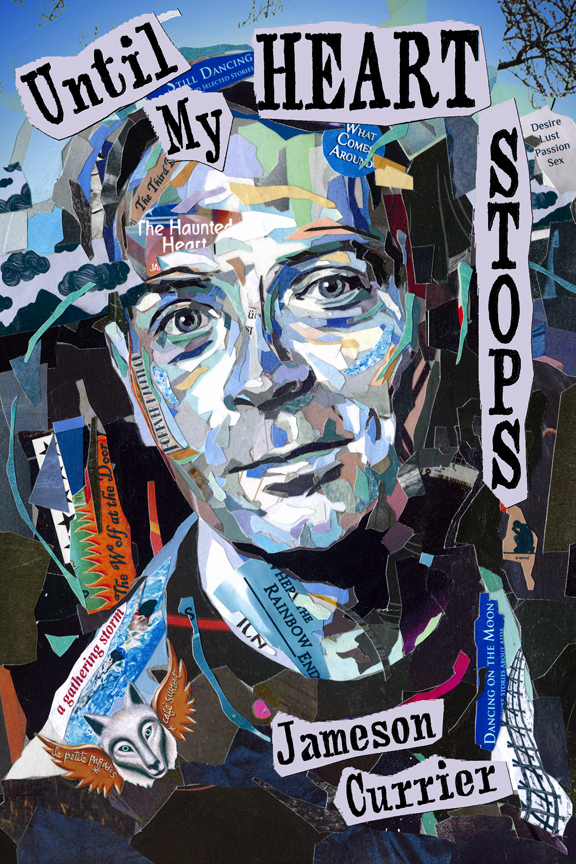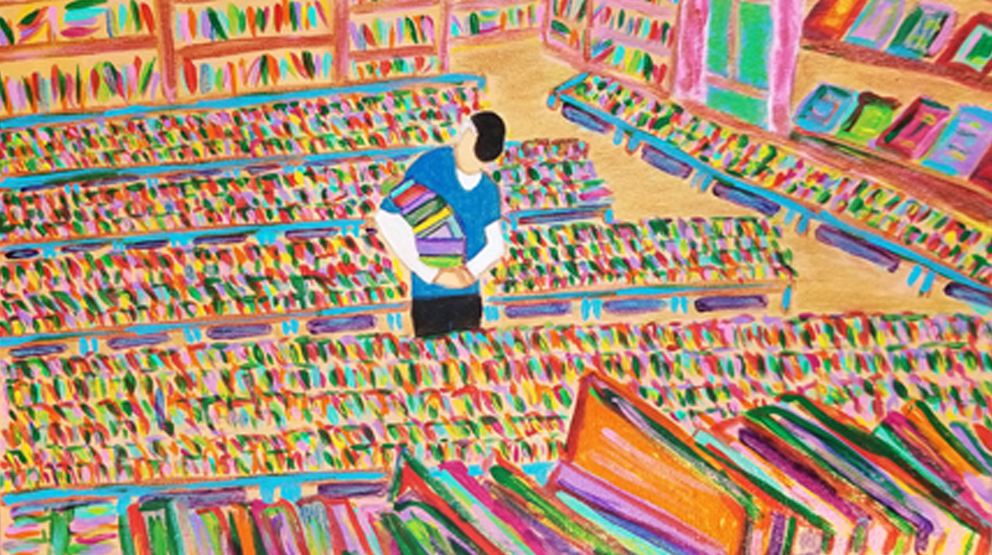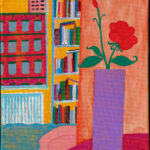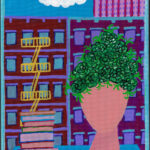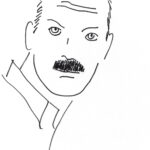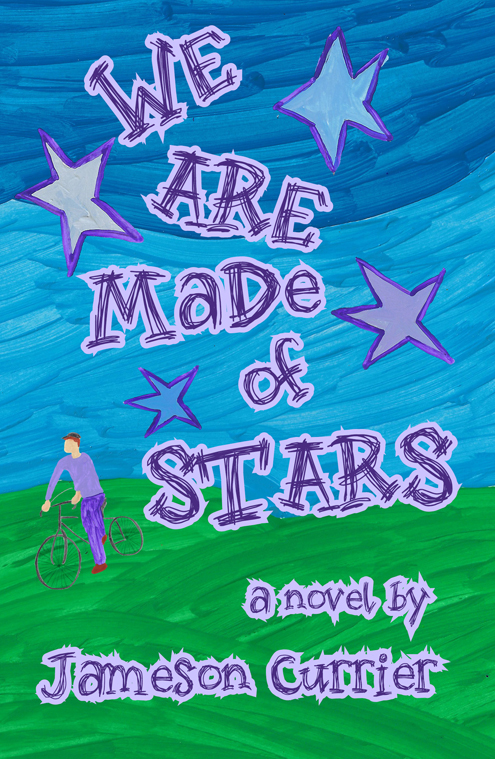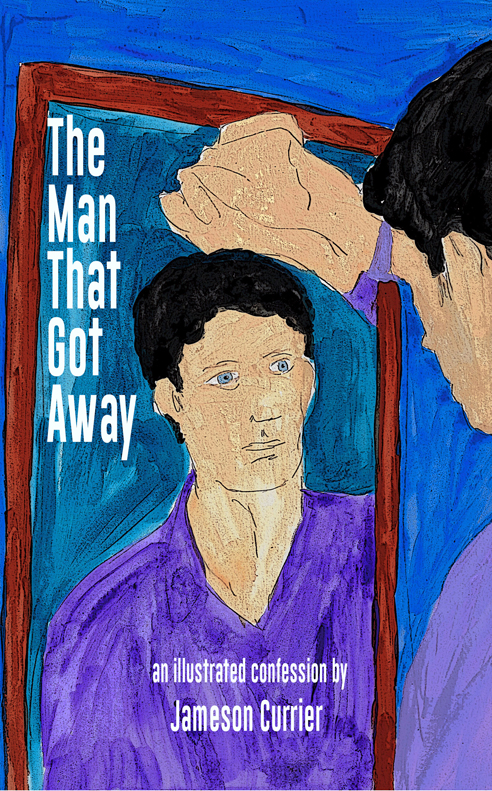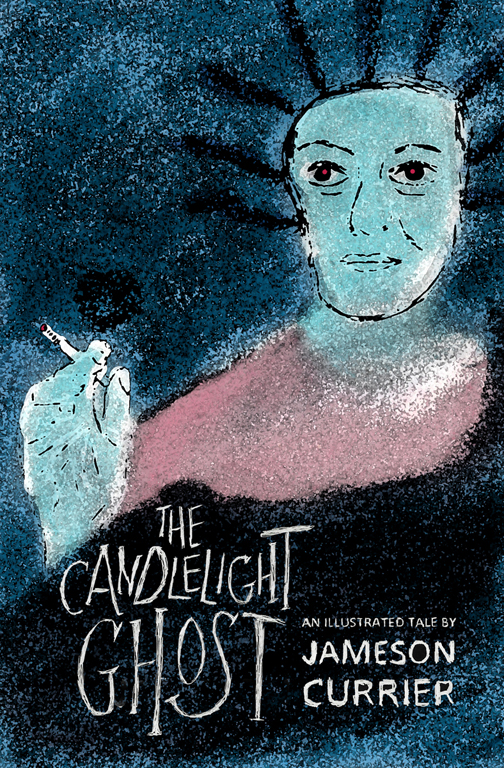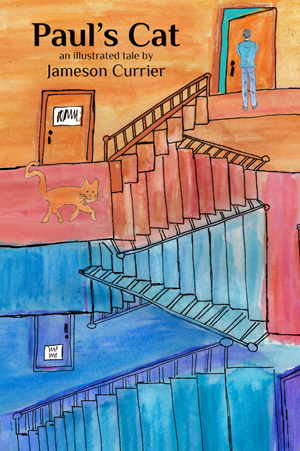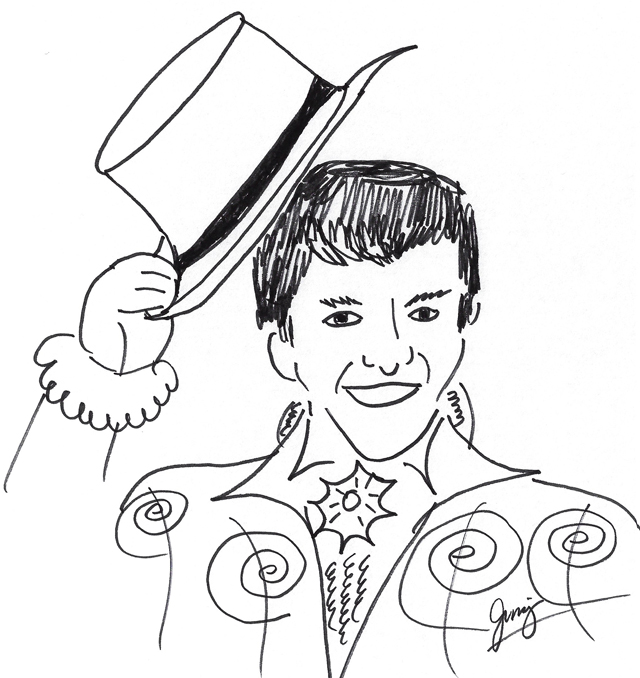
sketch of Liberace
by Jameson Currier
ink on paper
20250124005
A FEW MINUTES WITH LIBERACE
by Jameson Currier
One of the things that irony teaches us is never to be surprised. This thought ran through my mind in Las Vegas as I stood at a souvenir counter in a strip-shopping mall and debated whether or not to buy a Liberace ashtray. I am neither a Liberace fan nor a smoker, but I enjoy collecting local tchotchkes from my vacations. I was looking for something distinctly Vegas to buy. The gift shop is in one of two sites the Liberace Museum occupies in storefront spaces located in a one-level strip-shopping mall. Outside, between the two buildings, rows of metal roofs and hoods of cars wavered in the desert heat of the black tar parking lot.
I’d flown to Vegas to meet my college roommate, John, for a vacation. I had been on business in Chicago; he lived in San Diego. On my arrival I found myself jet lagged, and my skin over sensitive to the sun from pain medication I was taking for a back problem. Our days were spent taking monorails to look at the insides and outsides of the giant casinos such as Luxor, Caesar’s Palace, and the Venetian, as if they were architectural wonders full of priceless art. In the evenings we crashed early, exhausted from all that motion and our stomachs bloated from early-bird bargain buffets.
We took a break from Vegas for a two day trip to see the Hoover Dam and the northern rim of the Grand Canyon. On our way back into Vegas we decided to use the rental car to spend a few extra minutes to visit the Liberace Museum, located on the outskirts of the main Vegas area. It seemed like the campy, gay thing to do, after all. This was the first vacation I had planned in some time which had not been planned around a gay-resort destination.
The gay scene in Vegas is about as underground as it can get, unless you factor in the one or two drag revues playing at the casinos which feature female impersonators doing the usual Cher, Bette, and Diana imitations. Our first night in Vegas John and I had made an attempt to locate a gay bar. From one of our guide books, we had read that there were none located where we were staying, at the southern end of the Strip, the generic nickname for the town’s main drag, Las Vegas Boulevard, but that there was a cluster of gay bars and businesses nearby, settled close to one another in an area called the Gay Quarter, along Paradise Road, just below Tropicana Avenue. The streets of Vegas are laid out in a pseudo-grid version that look easy to decode on a map, but are actually more difficult once you get out into the distracting lights and signs of the casinos. We decided that by walking a few blocks east we would reach the local gay bookstore and inquire about the nearby bars. One block in Vegas, however, is worth about ten in another city, and leaving the Strip we were soon walking within a dimly lit industrial nightmare: undeveloped land, no traffic, confusing street signs, and not a clue to where we were headed. After we reached the first intersection, about thirty minutes later, we luckily flagged down a taxi driver who dropped us off at the intersection we had set out for (and which would have taken us another hour to reach by foot and bravado). We spotted the gay bookstore and went inside.
The bookstore was relatively empty (maybe two other people besides ourselves and two men behind the sales counter) and sold more erotica items and videos than they did books. One of the two young men behind the counter, the one with the wide smile, long hair, and the earring (in his left ear, not his nostril or eyebrow) pointed out the scenario of bars within the Quarter, an area of one-story street front commercial looking buildings. We tried to inquire what kind of scene was happening at each bar but John and I were dressed in our most “vanilla” outfits (polo shirts and khakis) and our own lack of gay specificity didn’t elicit detailed descriptions. (We reeked “tourist” to the “nth degree.”)
Outside on the sidewalk, John and I debated which bar to check out first, when a dark-looking, well-built man who had been smoking a cigarette nearby provided us with a better description than the sales clerk had about the two bars across the highway. (One had a better dance scene than the other but it started later.) We jaywalked behind him across the highway and followed him inside the supposedly busier bar without the dancing.
There was not much of a crowd here, however. The requisite slender, young bartender in T-shirt and jeans was working the center of a circular, wooden bar counter. Inside the bar it was darker than the night was outside. There were maybe ten customers and the only difference between this bar and one which you would find in, say, Worcester, Massachusetts, was that along with the cigarette machine, juke box, and scattered gay publications by the door, there were slot machines recessed into the top of the bar counter so that a customer could easily “drink and play.”
We bought our new friend a drink. (I thought he was possibly interested in hooking up with John, as is usually the case when the two of us are out together.) But as it happened, our friend, a personal trainer by trade, was more interested in trying to sell us admission cards to one of the larger jazz clubs on the Strip. (“Hey, a lot of gay guys like you go there.” Translation: guys who pass for straight—or worse—married guys away from home and out looking for “trouble.”) But when it was clear we were not even nibbling at his wares, the trainer left disgusted and we fell into a conversation with another young man, a reedy blond with large, blood-shot blue eyes and a gravelly voice, who talked about how many crack heads there were in this town (and included himself).
It was still early according to “gay time”—barely after 10 p.m.—and John was much more determined than I to party. We had another drink, watched a repairman come in and fix one of the bar counter slot machines, and then asked the bartender to call us a cab to take us back to our hotel. John debated whether to stay behind on his own but decided against it. The wait for the cab was a long one—and our bar hunt was to be the only gay excursion of our trip. That is, until we decided, impulsively, to visit the Liberace Museum.
The Liberace Museum houses the late showman’s collections of antique, rare, and gaudy pianos, automobiles, stage costumes, and jewelry. Opened in 1979 by Liberace himself, among the things you are likely to find are Chopin’s piano from the early 1800s, a mirrored-tiled Rolls Royce, and the world’s largest Austrian Rhinestone, totaling 115,000 karats and weighing over 50 pounds. The Museum is also filled with mannequins wearing the performer’s trademark gold lamé dinner jacket, ostrich feather and mink capes, and the notorious red, white, and blue hotpants used in his salute to the 100th anniversary of the Statue of Liberty.
The walk through the rooms and exhibits of the Liberace Museum took less than an hour and was full of eye rolls, smiles, and giggles. It occurred to me by the time we entered the second building of the Museum, that the visitors were easily divided into Us and Them and the Us team was clearly in the minority. Nowhere in the Museum was Liberace’s homosexuality revealed. (This was the man who successfully sued a British newspaper for hinting at his homosexuality early in his career and later in life suggested he was dying from a watermelon diet and not AIDS). The closest moment of truth arrives in a video segment broadcast on a television monitor when, amongst guests such as Debbie Reynolds, one of Liberace’s young protégés is introduced to the studio audience. (Wink, wink.)
Today, Liberace’s closeted but flamboyant homosexuality has become synonymous with his name. Nobody likes a Liberace queen (though they may find him entertaining). But unlike other closeted stars and celebrities whose sexuality have been revealed and dissected after their deaths (James Dean, Rock Hudson, Montgomery Clift, for example), Liberace has not become a gay icon or role model. (Nor was that his intent. He deliberately developed an audience outside of the gay community.) I can’t say that I ever met Liberace or saw him perform live in concert. And I never wanted to. If he was ever on a television set that I was watching, I changed the channel quicker than you could say “Lawrence Welk.” If the truth be known, as a boy, Liberace appalled me. I spent twelve years studying the piano and did my best to be serious about it. I did not want a flashy costume to get in the way of my performance. Or overpower it. And behind my closed bedroom door, listening to show tunes on a portable stereo player, it seemed somehow all right to emulate Barbra or Liza. But Liberace? I don’t think so. Liberace was not part of the same sexual consciousness that summoned up images of Steve Reeves in a toga or Marlon Brando in a torn T-shirt.
But Liberace did seep into my consciousness, nonetheless. I knew who he was and I didn’t want to be him. I once had the opportunity of meeting Liberace. In the mid-Eighties, the publicity firm where I worked representing a Broadway play was also publicizing Liberace at Radio City Music Hall. But I declined to see both the show and meet the performer. The sad thing about Liberace today is not that he never owned up to his sexuality in public but that this campiness and outrageousness has outstripped any appreciation or respect of whatever genuine talent he might have possessed. Fame, it seems to me, pushed him harder than art did. Or maybe I have misread him entirely. Perhaps he was never a great talent. Perhaps his art was his campiness and his music merely incidental to the image. How easily, for instance, can you identify Liberace playing on the radio?
I’d like to say that the Liberace Museum was merely a frozen moment in time, an homage to a man and his closet, a product of its own era. But the truth is that it is reflective of Vegas today: showy, glitzy, with all meaning and subtext hidden. Sin City is family and tourist oriented now in the same way that Times Square has been Disneyfied. It’s also reflective somewhat of the state of a large public unawareness of the history of gay life in the United States. Nowhere to my knowledge is there a museum devoted to an individual’s struggle with his gay sexuality nor to our collective gay experience with identity and acceptance. (Even the Andy Warhol Museum in Pittsburgh plays minimal interest to the artist’s sexuality.)
I ended up not buying the Liberace ashtray. And I didn’t buy a Liberace scarf, a Liberace necktie, or a Liberace T-shirt. What I bought was a chilled bottle of spring water with the Liberace script “L” logo on the label. I was dehydrated. We had been driving for hours that day and the heat outside was over 100 degrees. The water was pleasant, welcome, needed, and replenishing, something the Museum was not. Outside, walking to where we parked the rental car, I spotted a familiar looking store across the highway. I looked around and told my friend John that we were in the exact area of the gay bars we had been looking for a few days before, struggling in the dark to find the Gay Quarter. He did a double take and laughed, recognizing the gay bookstore we had discovered and the ironic moment we had just uncovered: The Liberace Museum is at the heart of gay Vegas.
The empty Liberace bottle stayed in the hotel room for another day or so, my unintentional shrine to the superpopularization of a man who despaired of the public really understanding him. It went in the trash before we checked out. I suppose I could have filled it up with water from the sink and carried it with me. But somehow that didn’t seem right. Why adorn the substance when the substance is what is merely desired? I went thirsty for a while. And then somewhere at the airport I drank water from a fountain.
___________________________________
“A Few Minutes with Liberace” was written in 2000 and first published in Until My Heart Stops, Intimate Writings by Jameson Currier (Chelsea Station Editions, 2015).
